Benin Art And Architecture - Culture (10) - Nairaland
Nairaland Forum / Nairaland / General / Culture / Benin Art And Architecture (206815 Views)
Art And Architecture Of The Igbo People / The Art And Architecture Of Yorubaland! / Show Pictures Of Africas Art And Archaeological Treasures (2) (3) (4)
(1) (2) (3) ... (7) (8) (9) (10) (11) (12) (13) ... (25) (Reply) (Go Down)
| Re: Benin Art And Architecture by PhysicsMHD(m): 10:37pm On Apr 12, 2011 |
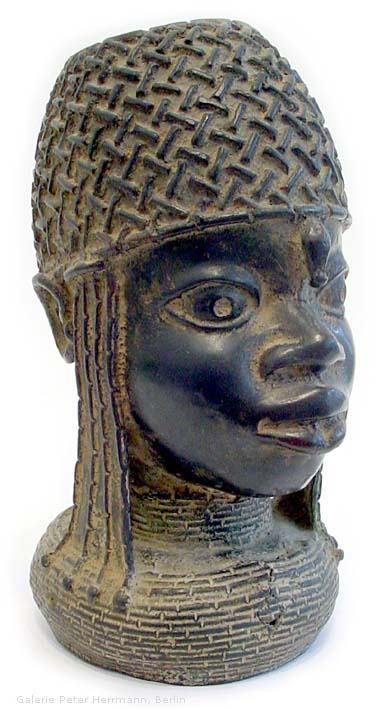 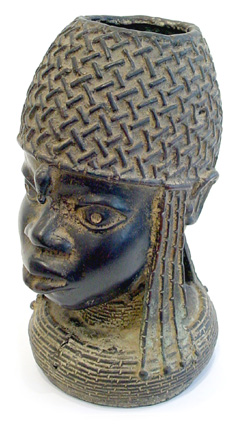 Oral tradition dates this object, one of the small memorial heads once housed in the Obaseki shrine, to the year 1884. It is said to have been made in memory of a well-known figure from Benin, presented to us as "Iviovor Edion Edo," aide-de-camp of the exiled Oba after 1900. Unfortunately, a TL analysis is not available to confirm this date as it is in the case of the other three heads because the remains found of a potential clay core are not geologically (i.e. TL) measurable. Stylistically, this head is closely aligned with early heads from Benin, featuring a coral cap, single pearl on the forehead, bulging coral collar and hanging pearl plaits. The face, however, features characteristics more reminiscent of Benin's later, more realistic phase of bronze casting and, furthermore, is smaller than the 16 th -century heads. The typical hole in the back of the head is still present, but its function as a stand for holding ivory was rendered obsolete by the shape of the cast. |
| Re: Benin Art And Architecture by PhysicsHD: 10:43pm On Apr 12, 2011 |
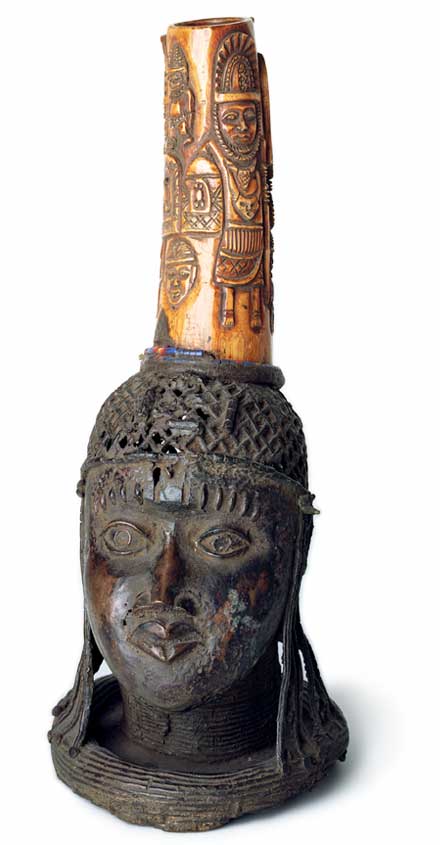 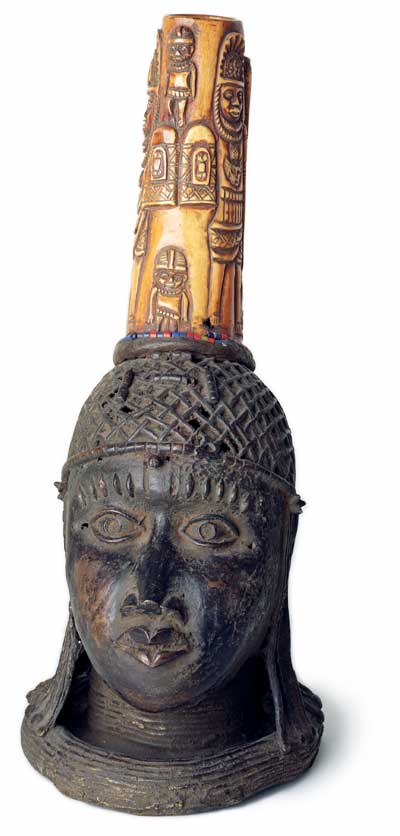 Two Heads with Ivory Benin, Nigeria 18th/19th century Bronze 60 and 61 cm The original ivory top pieces seen here make these two heads very valuable. Quite often, these pieces was detached from the heads and sold separately, making heads with original attachments hard to find. Stylistically, the two heads here bear reference to Benin bronzes from the 16 th century, with coral head caps, single pearls on the foreheads, flared coral collars and hanging pearl plaits. The two faces, however, do not feature the very dignified and smooth features of the earlier Benin bronzes; instead, they are idiosyncratically stylised, suggesting that the heads were intended primarily as bases for the ivory attachments. |
| Re: Benin Art And Architecture by PhysicsHD: 10:45pm On Apr 12, 2011 |
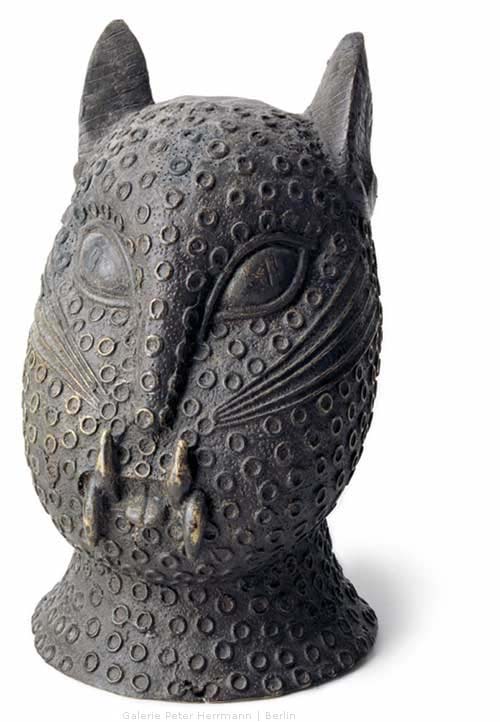 Leopard Head Benin, Nigeria 19th century Bronze 27,5 cm In Benin, the leopard head motif was most often used for masks worn on warriors' hips; a portrayal like this one without discernible function is much rarer. It was perhaps intended for the altar of an Oba given that in many parts of Benin, the leopard still serves as a metaphor for the king. |
| Re: Benin Art And Architecture by PhysicsHD: 10:47pm On Apr 12, 2011 |
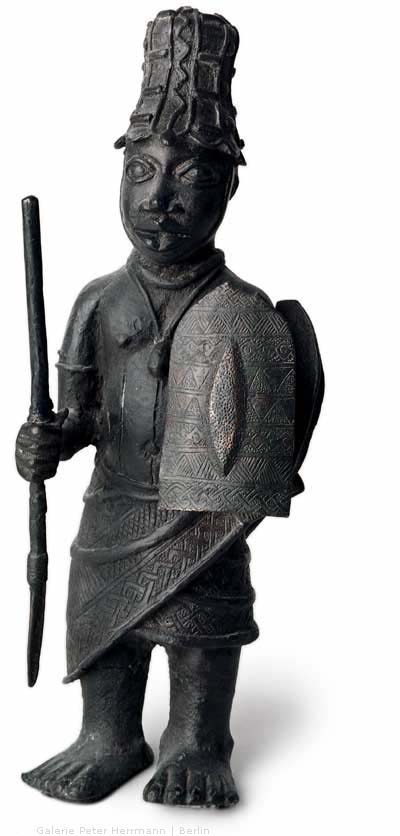 Warrior Benin, Nigeria about 1880 Bronze 32 cm This warrior from Benin wears a tall, ornamented helmet, a shield, a spear and a wrap-around skirt with stiff appendage. The tall and pointy appendage is very typical for pieces from Benin. |
| Re: Benin Art And Architecture by PhysicsHD: 10:49pm On Apr 12, 2011 |
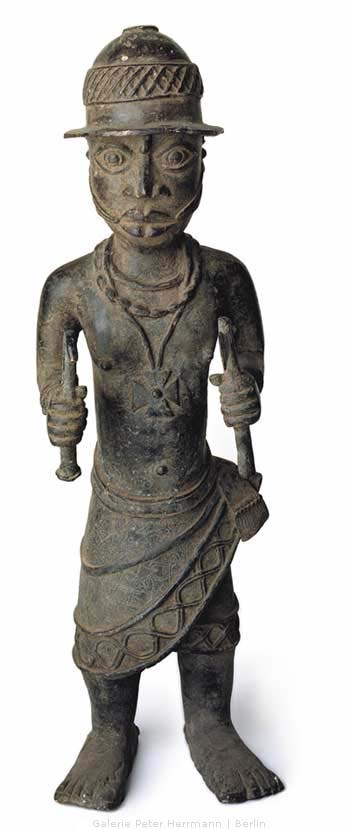 (Ewua-) Dignitary Benin, Nigeria + - 1800 55 cm |
| Re: Benin Art And Architecture by PhysicsHD: 10:53pm On Apr 12, 2011 |
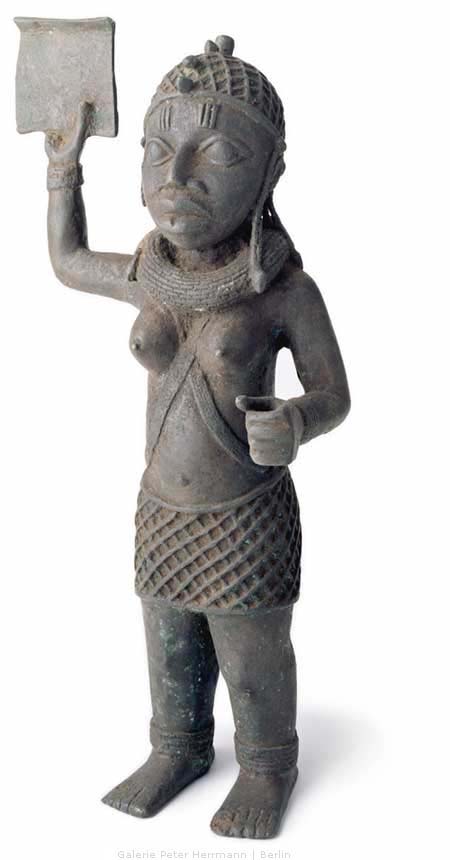 Female Figure Benin, Nigeria about 1500 44 cm This figure is exceptional by mere virtue of its sex: in Benin, the depiction of women was almost exclusively reserved for Queen Mothers, with their characteristic peaked, piled-up hair-styles and coral pearls. This figure, too, wears a coral head cover, though hers lies flat against her head and lacks the braided plaits that usually hang down from such caps. The cap and the rotund coral collar - typical of 16 th -century pieces - identify her as a member of palace society, though the exact position she held and the precise meaning of the tablet-like item in her right hand cannot be definitively determined - all the more so given that no objects of comparison whatsoever are known. |
| Re: Benin Art And Architecture by PhysicsHD: 10:54pm On Apr 12, 2011 |
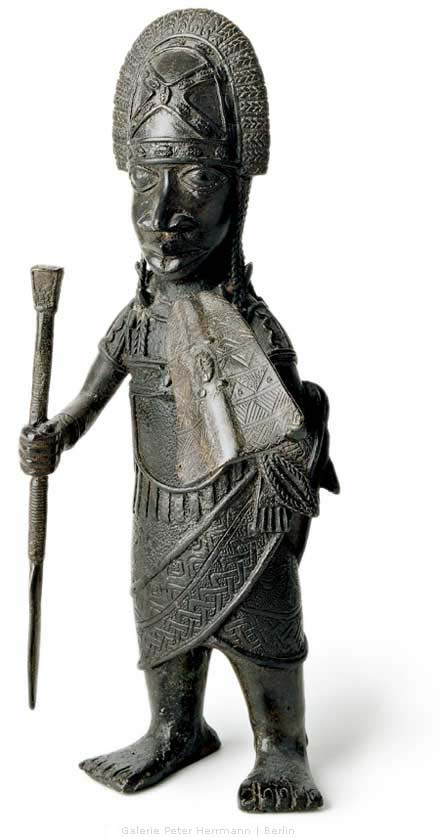 Warrior Benin, Nigeria about 1700 33,5 cm The depiction of a warrior in this form is very rare. The figure wears a rounded, cowry-adorned helmet, leopard-teeth necklace, shield and spear, as well as a wrap-around skirt with stiff appendage. |
| Re: Benin Art And Architecture by PhysicsHD: 12:12am On Apr 13, 2011 |
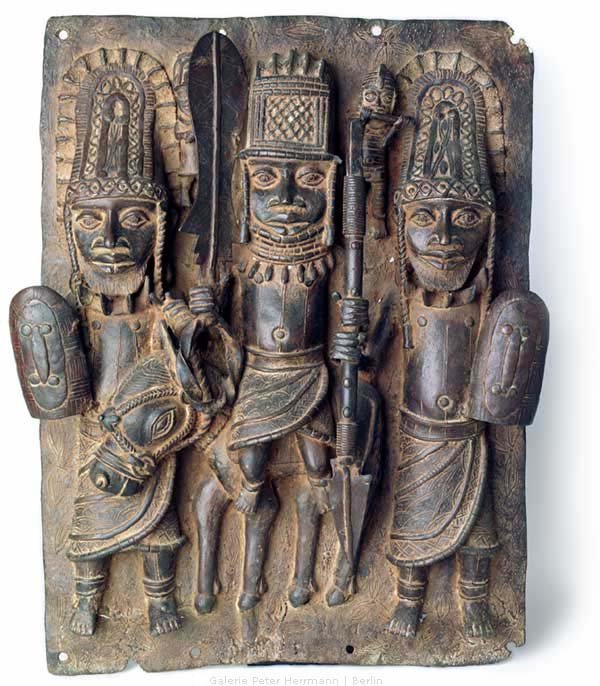 Relief Plaque with Warriors Benin, Nigeria 19th century Bronze 47 x 37 cm The headdress of the three warriors on this plaque is reminiscent of that depicted on plaques of Esigie's warrior father Oba Ozolua (1481-1504) and his entourage. Ozoluas' rectangular headdress and the rounded, richly-decorated headdress of his attendants are very typical for this motif, as are the two weapons depicted on this plaque. Only the presence of the horse, not hitherto connected with Ozolua, and absence of the iron cloak for which the Oba was so famous are unusual. Cp.: Barbara PLANKENSTEINER (Hg.): Benin. Könige und Rituale. Höfische Kunst aus Nigeria, Wien 2007, S. 438/ 440. |
| Re: Benin Art And Architecture by PhysicsHD: 12:13am On Apr 13, 2011 |
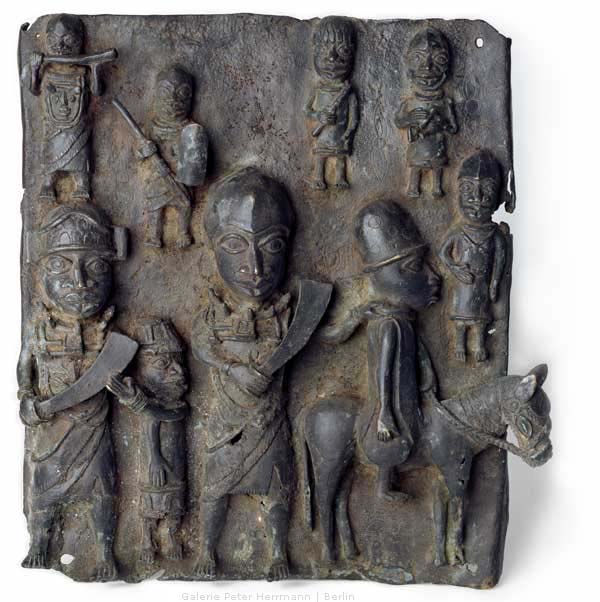 Relief Plaque with War Scene Benin, Nigeria 19th century Bronze 49 x 45 cm Relief Plaque with War Scene: This bronze plaque depicts victorious Beninese warriors and their captives in an uncommon variety of shapes and forms and with uncommon detail. At the top left of the image, a hornblower musically accompanies the triumphal procession. The warrior in the middle drives a prisoner sitting on a small horse, holding him on a collar. The fact that the prisoner rides horseback indicates that he has a high rank, but his importance is qualified by the size ratios of the figures on the plaque; the central Beninese warrior is much larger, a clear emphasis of his position as victor. In addition, attributes like the leopard-teeth necklace and crocodile-skin helmet worn by that figure mark him as the highest ranking on the plaque. The warrior on the very left grasps the wrist of an even smaller prisoner and appears to be threatening him with his sabre. At the top of the plaque, several additional, small warriors belonging to the entourage are depicted. |
| Re: Benin Art And Architecture by PhysicsHD: 12:14am On Apr 13, 2011 |
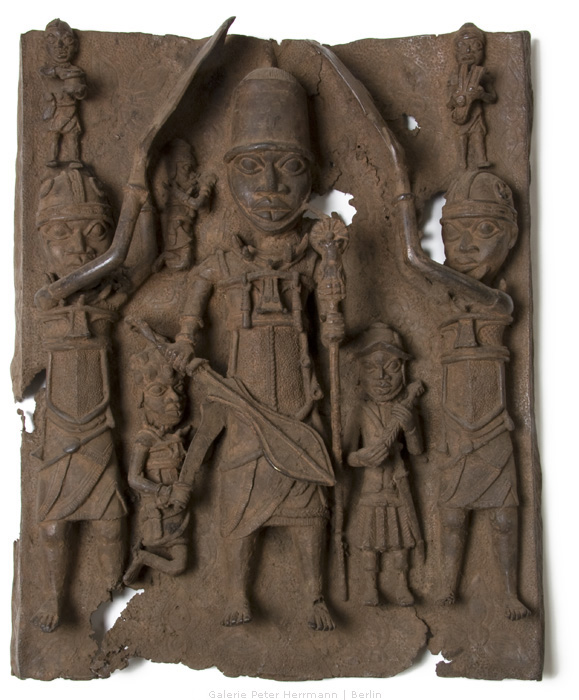 Relief Plaque with Warrior Benin, Nigeria About 1800 Bronze 50 x 40 cm |
| Re: Benin Art And Architecture by PhysicsHD: 12:15am On Apr 13, 2011 |
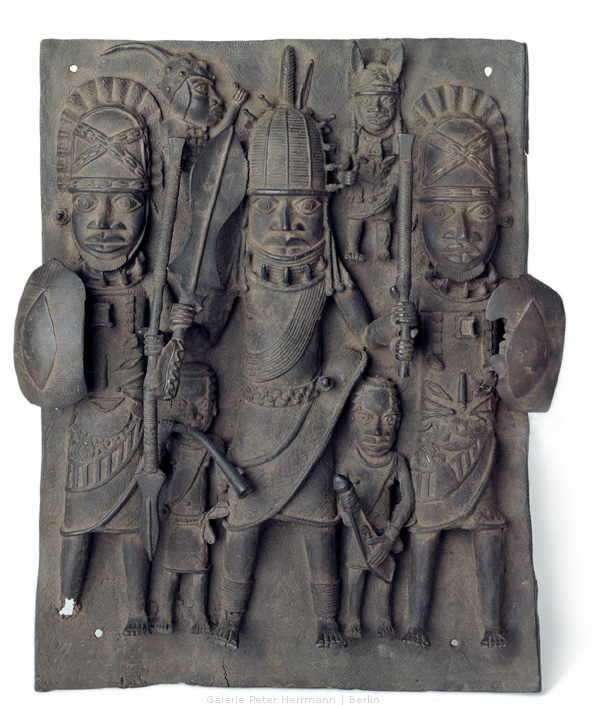 Relief Plaque with 7 Warriors Benin, Nigeria About 1830 Bronze 54 x 41 cm |
| Re: Benin Art And Architecture by PhysicsHD: 12:23am On Apr 13, 2011 |
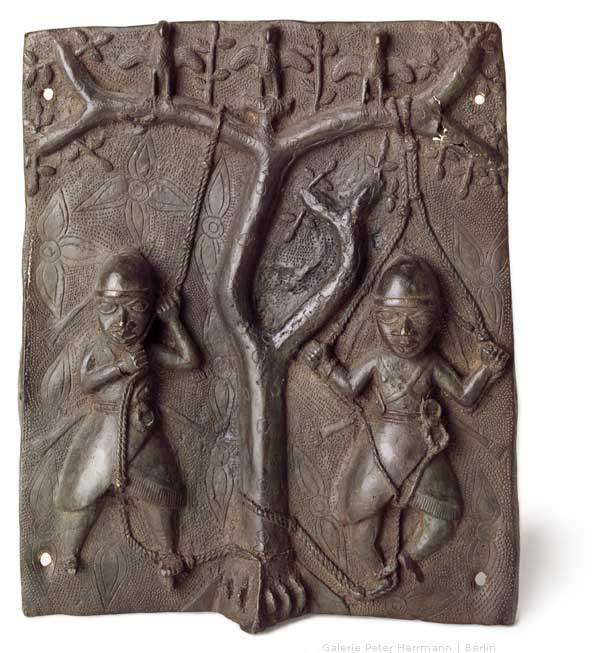 Relief Plaque with Amufi Acrobats: Benin, Nigeria 16th-17th century Bronze 58 x 43 cm This relief depicts two acrobats of the Amufi ceremony. As members of one of Benin's many guilds, the acrobats are responsible for climbing trees for certain ritual purposes and for catching osprey for the Oba to sacrifice at the Ugie celebration. It is believed that these members of the Amufi guild are endued with special spiritual powers that enable them to climb the highest treetops, a feat most ordinary people would not and could not achieve. In this particular ritual, the acrobats climb a very high tree, secretly prepared with ropes the night before. Upon reaching the highest perch, they loop the ropes around themselves and leap into the air with arms and legs spread, swinging themselves in large circles and flapping their rattle-draped arms as though they were wings. On the uppermost part of the relief plaque, three big birds perch atop the tree - perhaps the ospreys caught for the Oba by the acrobats. This plaque is remarkable in that it portrays both people in motion and nature, an unusual combination for Beninese plaques. Only one other plaque is stylistically similar: the Relief Plaque with Leopard Hunt. Given that both pieces depict people in unusually contorted positions and trees bedecked with lovingly-formed leaves, one can assume that both plaques were crafted by the same artist, whom Fagg calls the "Master of the Leopard Hunt." His unique, individual style arguably makes him Benin's most significant artist. In general, the minimal stylistic variation of Beninese plaques over the course of many centuries make most efforts at attribution futile; the so-called "Master of the Leopard Hunt" is one of the few artists for whom experts make efforts at attribution. Cp.: Barbara Blackmun, in: Barbara PLANKENSTEINER (Hg.): Benin. Könige und Rituale. Höfische Kunst aus Nigeria, Wien 2007, S. 334/ 335. |
| Re: Benin Art And Architecture by PhysicsHD: 12:23am On Apr 13, 2011 |
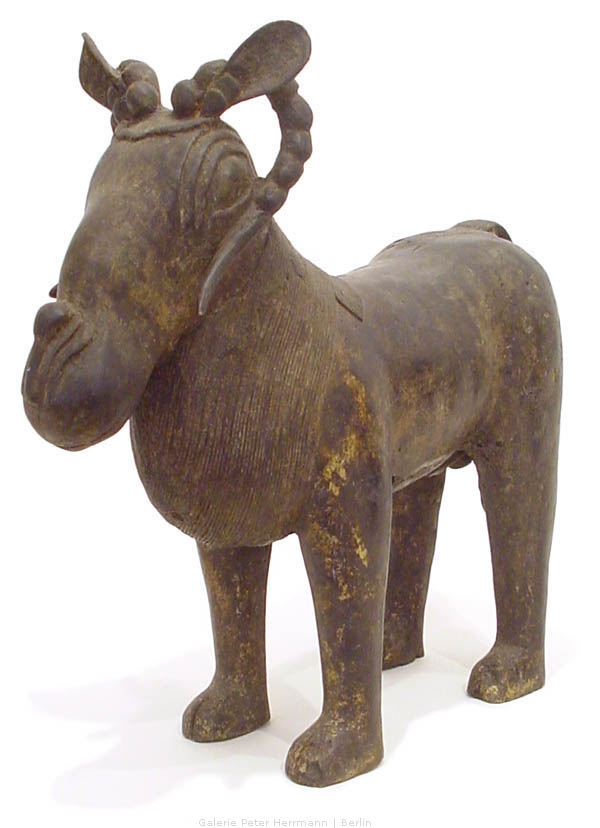 Ram Benin, Nigeria about 1600 Bronze H - 33 cm, L - 33,5 cm A very similar ram can be found in the British Museum in London, though that object is an aquamanile - that is, a ewer. Bronze objects like rams and leopards were often used as ewers for ceremonial ablutions. Though this ram is very similar to the one in London, it lacks the openings on the head and nostrils typical for an aquamanile, and was thus probably created as a symbol of royal power for the altar of a king. In Benin, the ram stands for masculinity and perseverance and was traditionally sacrificed at the Ague Ceremony, inaugurated by Oba Esigie (-1550) as part of an important festival. The naturalistic depiction and lack of symbolic overload of this ram seems to confirm its old age, as determined by TL analysis. Cp.: W./ B. FORMAN, Philip DARK: Die Kunst von Benin, Prag 1960, S. 58/ 59. Barbara PLANKENSTEINER (Hg.): Benin. Könige und Rituale. Höfische Kunst aus Nigeria, Wien 2007, S. 433. |
| Re: Benin Art And Architecture by PhysicsHD: 12:25am On Apr 13, 2011 |
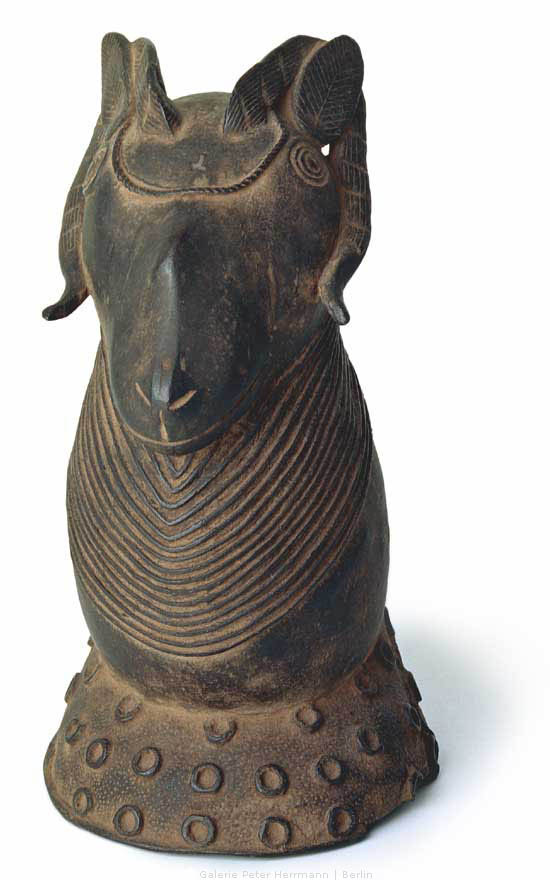 Benin, Nigeria Bronze H - 33 cm, L - 33,5 cm This mutton is a very special, unique item for which there are no stylistic relatives or objects of comparison. Its technical distinctiveness and old age (600 years) - recently determined with new methods - lend this object a particular rarefaction. The head is very sensitively rendered and boasts many finely-expressed details, like ears with leaf motif and small chain. The animal's neck evolves directly into a type of base, which, for its part, is decorated with circles. |
| Re: Benin Art And Architecture by PhysicsHD: 12:27am On Apr 13, 2011 |
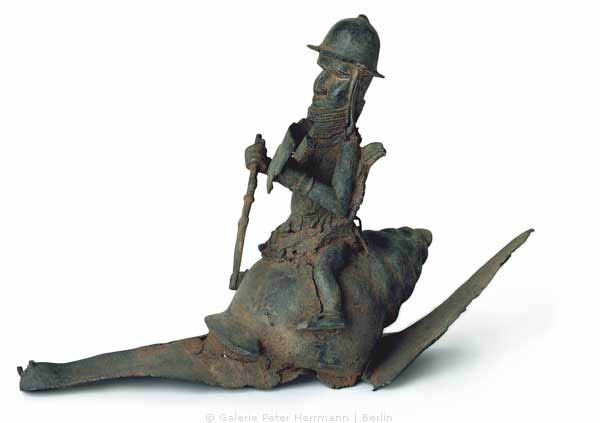 Warrior Riding a Snail Benin, Nigeria about 1900 Bronze H - 29 cm, L - 43 cm None of the relevant literature makes mention of this or any warrior on a snail. Though the characteristic coral necklace worn by the rider marks him as a member of the royal court, the meaning of the snail can, at this point in time, only be guessed. Considering the fact that animals tend to be closely connected with specific myths, however, the snail may refer to a story concerning the founding of the kingdom of Benin, recorded by the chronicler of Benin Egharevba (1893-1980). According to that myth, the god Osanobua sent his sons to live on earth and instructed each of them to bring something useful with him on his journey. While the older ones chose things like magic or riches, the youngest, acting on the advice of a bird, brought a snail shell. Upon their arrival on earth, the sons discovered that their useful items from the sky could not be used down below. The youngest son, however, was told by the bird to turn over his snail shell, upon which an endless stream of sand began to pour out; the sand flowed continually, forming an enormous piece of land over which the son then reigned, thereby becoming the ruler of the world. This object may very well depict that proud, youngest son of Osanobua - who would later become the founder of the kingdom of Benin - sitting on his useful snail or taking it on a victory ride to celebrate his rule. |
| Re: Benin Art And Architecture by PhysicsHD: 12:28am On Apr 13, 2011 |
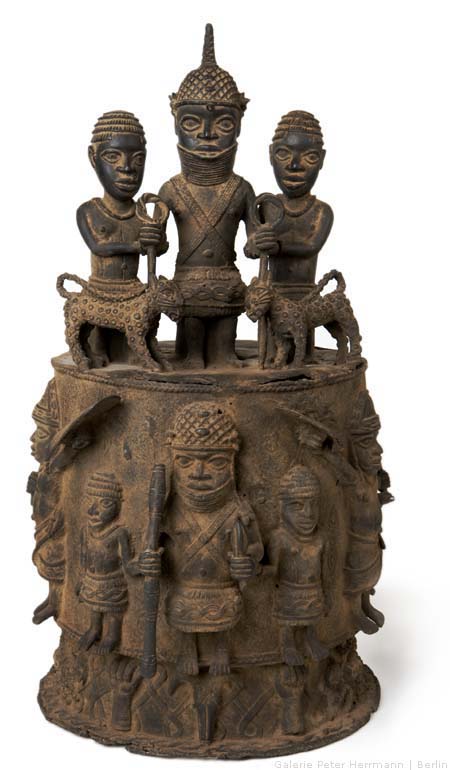 Altar of the Hand Benin, Nigeria About 1800 Bronze 55 cm |
| Re: Benin Art And Architecture by PhysicsHD: 12:29am On Apr 13, 2011 |
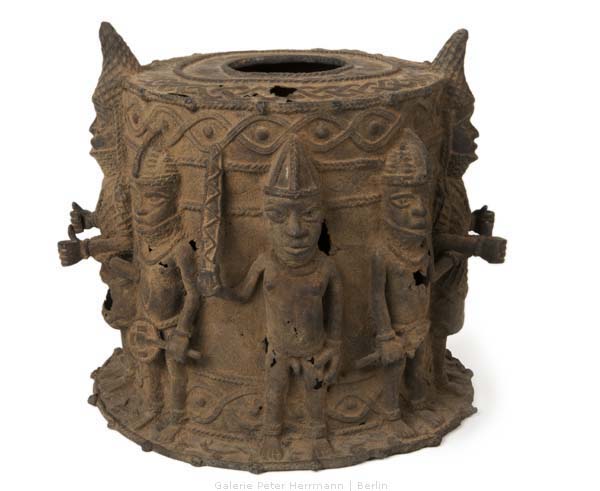 Altar of the Hand Benin, Nigeria About 1750 Bronze 27 cm |
| Re: Benin Art And Architecture by PhysicsHD: 12:30am On Apr 13, 2011 |
 Queenmother Benin, Nigeria Aboud 1600 Bronze 57 cm |
| Re: Benin Art And Architecture by PhysicsHD: 12:31am On Apr 13, 2011 |
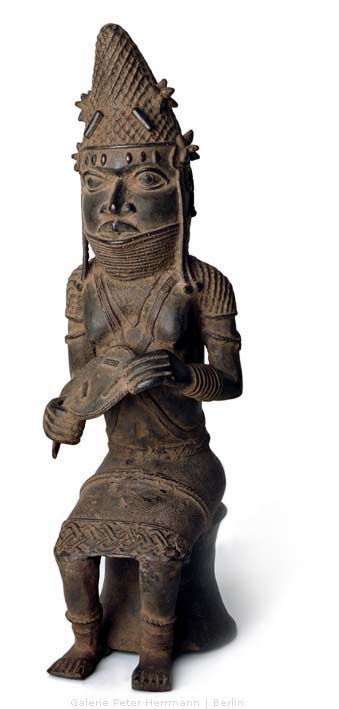 Queenmother Benin, Nigeria About 1700 Bronze 48 cm |
| Re: Benin Art And Architecture by PhysicsHD: 12:32am On Apr 13, 2011 |
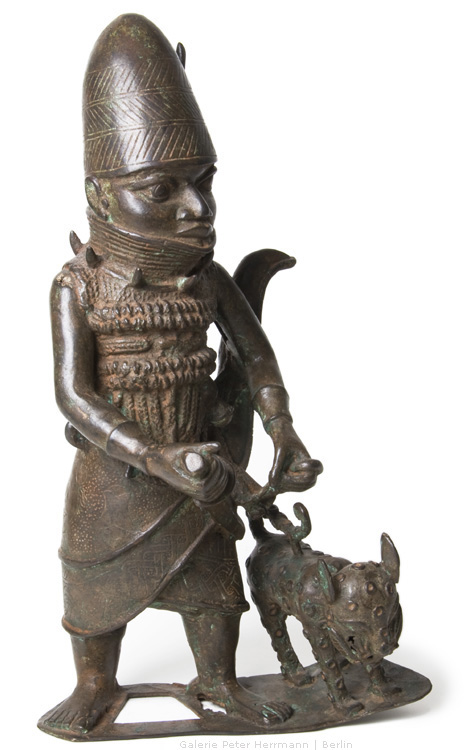 Warrior with Leopard Benin, Nigeria Bronze 44 cm |
| Re: Benin Art And Architecture by PhysicsMHD(m): 9:17pm On Apr 14, 2011 |
PhysicsHD: This is a depiction of an Iyase of Benin, apparently, going by the hat he's wearing. |
| Re: Benin Art And Architecture by PhysicsMHD(m): 10:09pm On Apr 14, 2011 |
A bridge in old Benin? "Just at Ikpoba it broadened out into a pool some twenty yards wide, quite shallow, but in the centre about six feet deep, with a nice sandy bottom, an ideal place for a bathe. There were the remains of a bridge which once had been a fine piece of native work, but had fallen into irretrievable disrepair. The water was excellent, in fact it is said that the Ikpoba water, carried down from the old city in demijohns, used to be sold in New Benin, sixty miles away, as a luxury" - R. H. Bacon, Benin: the City of Blood (1897) ^^^^ The book this quote is from has an exaggeratedly negative and low opinion of Benin owing to the attack on the intrusive and unwelcome expedition to Benin led by James Robert Phillips' party in January 4, 1897, that resulted in the death of Phillips and several European officers. For Bacon of all people (who uses extremely negative and sensational language against Benin throughout his book) to admit that the bridge was a fine piece of work means that even its remains were impressive. |
| Re: Benin Art And Architecture by PhysicsMHD(m): 10:40pm On Apr 14, 2011 |
A description of part of the deliberate burning of Benin: "This compound consisted of about a hundred houses, whose roofs made a good blaze. Behind the buildings there was a huge garden, which we never had time to explore, but it must have been quite a hundred acres, surrounded by a high red wall. It is not unlikely that it was the walking place of the King, and formed part of his compound, which the Juju prevents him ever leaving. That afternoon began the demolition of houses near the King's House, so as to make that portion of the town defensible by the Houssas after we had left. The destruction of those mud houses was a matter of some difficulty, gunpowder could not be used except in small quantities, when the difficulty of tamping rendered the charge useless ; the danger of firing the thatch from large charges was a risk not to be run. It was wearisome work, the red dust from the hard mud irritating the nose and throat to an amazing extent. The same afternoon a large party under Captain Campbell proceeded to the Queen Mother's House and destroyed it, so burning one more of the headcentres of vice in the city." -R. H. Bacon, Benin: the City of Blood (1897) |
| Re: Benin Art And Architecture by PhysicsMHD(m): 5:34pm On Apr 15, 2011 |
  |
| Re: Benin Art And Architecture by PhysicsMHD(m): 5:41pm On Apr 15, 2011 |
 "The royal palace of the oba or king of Benin was adorned with hundreds of elaborately ornamented plaques, such as this one, telling the story of court life. Cast in the lost wax technique by a highly skilled artisan, this plaque has the figure of a court nobleman or possibly a chief showing details of his regalia, including his helmet, an elaborate coral necklace, embroidered skirt, belt, and anklets." A close up of one of the Benin bronzes depicting a messenger. The rectangular object in his right hand has been interpreted as a leopard skin pouch by some (which is possible, though there is not an accompanying explanation for what the use of leopard skin pouches was in the context of the Oba's court), but I noticed that the circles on the object could be like the aro-oko symbols amazonia mentioned earlier (although I don't see any x's). Note the similarity between the object in the messenger's hand and the one that the female court official is holding from an earlier post: https://www.nairaland.com/nigeria/topic-582176.288.html#msg8113567 There are several other bronzes which depict the same kind of flat, rectangular object being held up by different court officials and I may post some others. |
| Re: Benin Art And Architecture by PhysicsMHD(m): 6:09pm On Apr 15, 2011 |
 Memorial head, terracotta, from Benin. Such memorial heads to an Oba (king) or chieftain, were placed on altars. Offerings were put into the opening at the top of the head. H: 24 cm Private Collection (T.E.L.), Vienna, Austria |
| Re: Benin Art And Architecture by PhysicsMHD(m): 6:24pm On Apr 15, 2011 |
[img]http://feastbowl.files./2010/10/nigeria-plaque.jpg?w=378&h=500[/img] Bronze plaque showing a central figure of an Oba or chief flanked by two attendants, made in Benin during the 17th century. |
| Re: Benin Art And Architecture by PhysicsMHD(m): 6:35pm On Apr 15, 2011 |
 Box in the Form of a Leopard's Head * Culture: Edo * Medium: Wood, metal * Place Made: Benin, Edo State, Nigeria * Dates: 19th century * Dimensions: 6 3/4 x 5 1/2 in. (17.2 x 13.9 cm) * Collections: Arts of Africa * Museum Location: This item is not on view * Accession Number: 56.6.31a-b * Credit Line: Gift of Arturo and Paul Peralta-Ramos * Catalogue Description: Box in form of feline head, wood with metal tacks over surface, ears protrude, teeth and fangs represented. Condition: generally good, slightly chipped. |
| Re: Benin Art And Architecture by PhysicsMHD(m): 6:39pm On Apr 15, 2011 |
 Hip Ornament with Human Face Benin court officials wear a variety of brass ornaments as part of their elaborate regalia for ceremonial occasions. Hip ornaments such as this one are worn on the left hip, covering the closure of a wrapped skirt. The three inlaid metal scarification marks on either side of the forehead identify the individual portrayed as a royal Edo man. * Culture: Edo * Medium: Copper alloy, iron * Place Made: Benin, Edo State, Nigeria * Dates: 18th century (possibly) * Dimensions: 6 1/2 x 4 1/8 x 2 1/4 in. (16.5 x 10.5 x 5.7 cm) * Collections: Arts of Africa |
| Re: Benin Art And Architecture by ezeagu(m): 7:08pm On Apr 15, 2011 |
PhysicsMHD: Uh, that's writing.  |
| Re: Benin Art And Architecture by PhysicsMHD(m): 7:18pm On Apr 15, 2011 |
ezeagu: I did acknowledge that it could be writing. I have seen about 6 or 7 other bronzes (brasses) depicting the same kind of thing and it always looked like the messenger was delivering a written message to me, but when I saw the circles, I bought the explanation of a leopard skin cloth/pouch written in a few of those art books. Though there was no explanation of what the function of such a leopard skin object was, or why it was rectangular and flat. When I remembered amazonia's post, it kind of put things in perspective and made me realize that it really could be writing. It kind of makes you wonder if there wasn't a stack of these somewhere in the Benin palace before the burning. I think this is the problem with keeping some things too secret. If the Benin priestly officials amazonia mentioned had published something about that writing system before the 1990s, that interpretation of these messenger figures would probably have also ended up in those art books in addition to claims about leopard skin objects. |
| Re: Benin Art And Architecture by ezeagu(m): 7:23pm On Apr 15, 2011 |
A court official is just randomly holding up a square piece of leopard skin.  Maybe the people who know all these Benin ceremonies, rites and rituals should be asked back at Benin. Maybe the people who know all these Benin ceremonies, rites and rituals should be asked back at Benin. |
(1) (2) (3) ... (7) (8) (9) (10) (11) (12) (13) ... (25) (Reply)
HAUSALAND: Teach Me Hausa / The Culture Lounge / Black African Nobility Of Ancient Europe
(Go Up)
| Sections: politics (1) business autos (1) jobs (1) career education (1) romance computers phones travel sports fashion health religion celebs tv-movies music-radio literature webmasters programming techmarket Links: (1) (2) (3) (4) (5) (6) (7) (8) (9) (10) Nairaland - Copyright © 2005 - 2024 Oluwaseun Osewa. All rights reserved. See How To Advertise. 74 |